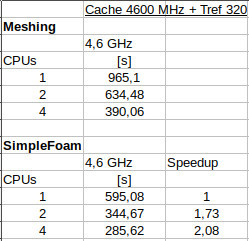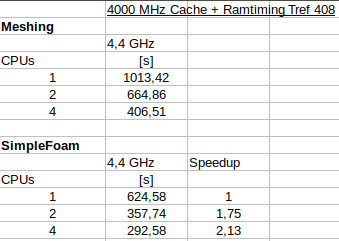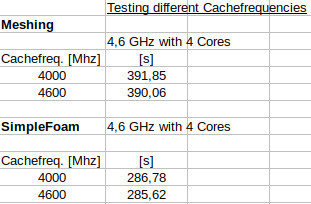 |
|
|
[Sponsors] | |||||
|
|
|
#201 |
|
New Member
Erik
Join Date: Jul 2019
Posts: 7
Rep Power: 6  |
I question myself, how to get more performance added to my overclocked cpu and ram.
So, i did some intensive testing on my 6600k workstation. I used 2x8 GB 3100 MHz 16-18-18-37 DDR4 Ram with a Command Rate of 1T. Some interessting correlations can be seen below. All tests are made on Linux Mint 19.0 with Openfoam 7.0. But lets show the best run first  . .  So, lets start at 4000 MHz cachefrequency and a Tref ramting of 408. Lower Tref values (ramtimings) and higher cachefrequencies for Intel Skylake architecture are beneficial. The benefit of higher cache is not that big, but ok.   Finally, i tested some Trefs between 408 and 320. As we know lower ramtimings and higher ramfrequencies are very good to lower the walltime. Higher cpu frequencies are very important to get low mesh times. But i dont expect this. All in all i got about 2% lower meshing- and walltime just by lowering Tref and higher cachefrequency. 
|
|
|
|

|
|
|
|
|
#202 |
|
New Member
Erik
Join Date: Jul 2019
Posts: 7
Rep Power: 6  |
I did some further testing comparison to Skylake, too.
Comparison for Skylake to some older notebooks: X200: P8600@2,4GHz DDR3@1066MHz Openfoam 6.0 ubuntu 18.10 T520: i7 2670qm@2,2GHz DDR3@1333MHz Openfoam 6.0 ubuntu 18.10 Skylake: 6600k@4,6GHz DDR4@3100MHz Openfoam 7.0 Linux Mint 19.0 T520+X200: 2 Node Cluster with Crosscable 1Gbit Ethernet AM2: 8 Node X2 4400+ with 1Gbit Ethernet Openfoam 7.0 Linux Mint 19.0 Code:
simpleFoam
| X200 | T520 | Skylake | T520 + X200 | AM2
-----------------------------------------------------------------------
1 | 2794,99 | 1242,46 | 595,08 | |
2 | 2099,58 | 822,6 | 344,67 | |
4 | | 653,52 | 285,62 | |
6 | | | | 625,02 |
16 | | | | | 465
With better IMCs over the last years we also got higher possible memory speeds. Code:
meshing
| X200 | T520 | Skylake | AM2
-------------------------------------------------------
1 | 3309,92 | 2244,18 | 965,1 |
2 | 2465,63 | 1568,04 | 634,48 |
4 | | 982,88 | 390,06 |
16 | | | | 1184
One core overclocked Skylake outperforms about 3times C2D and 2times Sandybridge in the meshing part. The older P8400 cpu shows to be about 7times slower in simpleFoam than the oced Skylake. Thats insane. 
Last edited by erik87; August 6, 2019 at 04:39. Reason: AM2 added |
|
|
|

|
|
|
|
|
#203 |
|
Senior Member
Join Date: May 2012
Posts: 546
Rep Power: 15  |
Ryzen 7 3700X, Single rank 2x8 GB DDR4 @ 3533 MT/s (14-15-15-35-1T)
Asus Prime X570-Pro Solus 4.0 OpenFOAM 7 Benchmark: Code:
# cores Wall time (s): ------------------------ 1 583.7 2 332.98 4 219.99 6 203.18 8 202.72 Code:
# cores Wall time (s): ------------------------ 1 17m 8s 2 11m 30s 4 7m 2s 6 5m 14s 8 4m 36s Edit: With 3600 MT/s the benchmark improves Code:
# cores Wall time (s): ------------------------ 1 562.51 2 312.16 4 199.88 6 180.35 8 177.39 Last edited by Simbelmynė; July 29, 2019 at 19:47. |
|
|
|

|
|
|
|
|
#204 |
|
Super Moderator
Alex
Join Date: Jun 2012
Location: Germany
Posts: 3,399
Rep Power: 46   |
Edit: found solution for SnappyHexMesh failing: SnappyHexMesh "Cannot open etc file"
Results with 2x Epyc 7551, 16x32GB 2Rx4 DDR4-2666 reg ECC, Openfoam-7 compiled from source along with OpenMPI; SMT disabled OS: OpenSUSE 15.1, kernel version 4.12.14; CPU governor: performance Solver times Code:
# cores Wall time (s): ------------------------ 01 907.7 02 534.64 04 211.67 06 138.11 08 101.9 16 53.93 24 42.43 32 36.79 40 37.17 48 31.1 56 29.52 64 27.73 As you can see from these new components, there won't be any Epyc Rome benchmarks from me any time soon. Zero availability of proper mainboards, and substantial price cuts for Epyc Naples and DDR4-2666 kind of forced me into this upgrade path. Meshing times for those interested: Code:
01 24m42.449s 02 16m54.417s 04 9m28.228s 06 6m35.526s 08 5m17.711s 16 3m36.410s 24 3m9.786s 32 3m26.846s 40 2m53.971s 48 2m42.073s 56 2m40.621s 64 2m34.309s Last edited by flotus1; September 21, 2019 at 19:34. |
|
|
|

|
|
|
|
|
#205 |
|
Senior Member
Join Date: May 2012
Posts: 546
Rep Power: 15  |
Hey,
Does OpenSUSE use lots of kernel backports similar to CentOS? I guess they do, but if not then 4.12 might be a tad too old. Anyways, very impressive results. |
|
|
|

|
|
|
|
|
#206 |
|
Super Moderator
Alex
Join Date: Jun 2012
Location: Germany
Posts: 3,399
Rep Power: 46   |
To be honest, I had to look up what a backport is first.
Too old for what, or how would I even begin to check whether the exact kernel of my distro is too old for my hardware? Officially, 4.12 is recent enough for Naples. |
|
|
|

|
|
|
|
|
#207 | |
|
Senior Member
Join Date: May 2012
Posts: 546
Rep Power: 15  |
Quote:
There are a few improvements with each kernel version that may or may not have an impact on performance. Sometimes there are regressions as well. Probably this is no big deal, but if you wish to get the last few % out of your system then it may be worth checking out. The easiest way to check is to just install a newer kernel. OpenSUSE can probably do this through YaST, and if you break your system you should be able to return to the stable kernel. |
||
|
|

|
||
|
|
|
#208 |
|
Super Moderator
Alex
Join Date: Jun 2012
Location: Germany
Posts: 3,399
Rep Power: 46   |
I have done my fair share of experiments with installing newer kernel versions. My takeaway is that I won't do it on a system I intend to actually use
 I will leave that to people who know what they are doing. As a side-note: I tried a few different compiler optimizations. Seems like there are no significant gains here, barely above the margin of error. |
|
|
|

|
|
|
|
|
#209 |
|
New Member
anonymous
Join Date: Oct 2019
Posts: 4
Rep Power: 6  |
2X EPYC 7302, 16x16GB 2Rx8 DDR4-3200 ECC, OpenFOAM v5, Ubuntu 18.04.3
Code:
# cores Wall time (s): ------------------------ 1 723.64 2 328.11 4 164.21 8 81.4 12 55.2 16 41.1 20 37.53 24 34.27 28 29.99 32 26.89 |
|
|
|

|
|
|
|
|
#210 |
|
Super Moderator
Alex
Join Date: Jun 2012
Location: Germany
Posts: 3,399
Rep Power: 46   |
Hot damn!

|
|
|
|

|
|
|
|
|
#211 |
|
Senior Member
Join Date: May 2012
Posts: 546
Rep Power: 15  |
So it seems that the architecture performs better than just looking at the increased memory bandwidth.
EPYC 7301: 36.8 s @ 2666 MT/s EPYC 7302: 26.9 s @ 3200 MT/s That is impressive! From Ryzen 3000 it can be seen that (all) the timings of the memory can play a huge role. Perhaps the XMP profiles and motherboard auto timings are better in tune with this release? Edit: Can you also test this with OpenFOAM v7? Most of the benchmarks here are with v6 or v7. |
|
|
|

|
|
|
|
|
#212 |
|
New Member
anonymous
Join Date: Oct 2019
Posts: 4
Rep Power: 6  |
Sure, below are the results with v7.
2X EPYC 7302, 16x16GB 2Rx8 DDR4-3200 ECC, Ubuntu 18.04.3, OF v7 Code:
# cores Wall time (s): ------------------------ 1 711.73 2 345.65 4 164.97 8 84.15 12 55.9 16 47.45 20 38.14 24 34.21 28 30.51 32 26.89 |
|
|
|

|
|
|
|
|
#213 | |
|
New Member
Join Date: Oct 2019
Posts: 3
Rep Power: 6  |
Quote:
|
||
|
|

|
||
|
|
|
#214 |
|
Super Moderator
Alex
Join Date: Jun 2012
Location: Germany
Posts: 3,399
Rep Power: 46   |
With v7, I had to do the following modifications to the script in the original post:
SnappyHexMesh "Cannot open etc file" and OpenFOAM benchmarks on various hardware |
|
|
|

|
|
|
|
|
#215 | |
|
New Member
Join Date: Oct 2019
Posts: 3
Rep Power: 6  |
Quote:
Here are my results for a 3900x running 2x16 3466 14-15-14-28 (with gear down mode and tight subtimings): Meshing: Code:
1 18m6.798s 2 11m30.075s 1.57 4 6m56.454s 2.61 6 4m53.322s 3.71 8 4m8.597s 4.37 12 4m5.024s 4.44 16 4m0.308s 4.52 20 3m43.419s 4.86 24 3m52.028s 4.60 Code:
# cores Wall time (s): ------------------------ 1 865.21 2 363.37 2.38 4 223.95 3.86 6 190.46 4.54 8 169.12 5.12 12 160.76 5.38 16 160.24 5.40 20 158.12 5.47 24 157.46 5.49 Edit: Now with scaling. Last edited by Lazyjones; October 26, 2019 at 05:26. |
||
|
|

|
||
|
|
|
#216 | |
|
New Member
Michael
Join Date: Feb 2016
Posts: 1
Rep Power: 0  |
Quote:
Wow, very impressive results! Could you please tell us which motherboard did you use? Because it's quite hard to find one that supports Rome officially. I've read on supermicro's site that some old motherboards do support Rome processors (with full 3200 MT bandwidth) but the motherboards have to be "revision 2". I don't know what that means, maybe it's just an updated bios... Regards |
||
|
|

|
||
|
|
|
#217 |
|
Super Moderator
Alex
Join Date: Jun 2012
Location: Germany
Posts: 3,399
Rep Power: 46   |
I can not tell you where to buy compatible motherboards, since I had the same problem. But I can answer the rest of your question:
On numerous occasions, AMD reiterated their claim that all SP3 Platforms will be able to get an upgrade from Naples to Rome. A promise they could not keep. The alleged reason (German site): https://www.planet3dnow.de/cms/49742...en-bios-chips/ Most retail SP3 motherboards shipped with a 16MB ROM. The bios version for Rome require 32MB ROMs. Hence many board revisions 1.x will never get support for Rome. There will not be a bios update, the hardware is incompatible. Board revisions 2.x solve this, mainly with a bigger ROM chip. So new hardware revision, not just a software update. Of course, these new revisions of older boards still lack support for some features of Epyc Rome, for example PCIe 4.0. When in the market for one of these boards, contact the retailer beforehand, and make sure they ship rev. 2.x. Actual new versions of retail boards with full feature support for Rome were announced, but have not yet been spotted in the wild. The lack availability is a recurring theme with AMD Epyc, unfortunately. |
|
|
|

|
|
|
|
|
#218 | |
|
Senior Member
Join Date: May 2012
Posts: 546
Rep Power: 15  |
Quote:
Nice results, especially considering you are on WSL in Win 10. Did you use the DRAM Calculator for your timings? |
||
|
|

|
||
|
|
|
#219 |
|
Super Moderator
Alex
Join Date: Jun 2012
Location: Germany
Posts: 3,399
Rep Power: 46   |
The single-core result looks off. Especially compared to some of the other Zen and Zen2 results already posted. I would not care too much about it, but it messes up the scaling.
|
|
|
|

|
|
|
|
|
#220 | |
|
New Member
Join Date: Oct 2019
Posts: 3
Rep Power: 6  |
Quote:
I have been wondering about that as well. Especially compared to the EPYC 7302 which has a significantly lower frequency. The Ryzen 3000 series does have some boost clock issues. This leads to my CPU not hitting the advertised boost clock of 4.6 GHz and instead only runs at ~4.3 GHz during 1-core loads. However, I am not on the latest BIOS, which should give around 5% more clock speed. Still, even at 4.3 GHz it should be faster than the 7302 at 3.3 GHz. Might be related to WSL. |
||
|
|

|
||
 |
|
|
 Similar Threads
Similar Threads
|
||||
| Thread | Thread Starter | Forum | Replies | Last Post |
| How to contribute to the community of OpenFOAM users and to the OpenFOAM technology | wyldckat | OpenFOAM | 17 | November 10, 2017 15:54 |
| UNIGE February 13th-17th - 2107. OpenFOAM advaced training days | joegi.geo | OpenFOAM Announcements from Other Sources | 0 | October 1, 2016 19:20 |
| OpenFOAM Training Beijing 22-26 Aug 2016 | cfd.direct | OpenFOAM Announcements from Other Sources | 0 | May 3, 2016 04:57 |
| New OpenFOAM Forum Structure | jola | OpenFOAM | 2 | October 19, 2011 06:55 |
| Hardware for OpenFOAM LES | LijieNPIC | Hardware | 0 | November 8, 2010 09:54 |